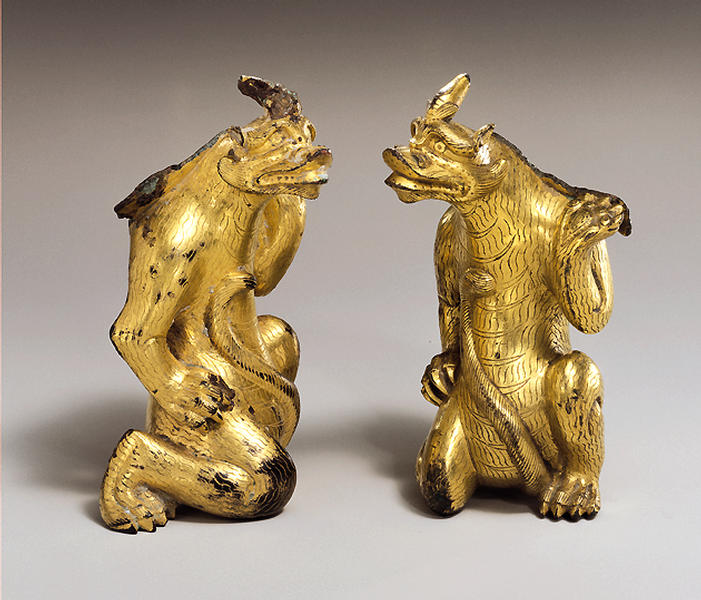Two Vessel Legs in the Form of Mythical Creatures
- China
- China, Han period
- 206 B.C. - A.D. 220
- Bronze with gilding
- H-9.8 D-6 W-5.5
Catalogue Entry
Mythical creatures proliferated in Han thought and art, with many new examples joining existing types. Most apparently had protective roles to play, conceptually occupying a zone between the comprehensible, ordered world of human society and the uncharted lands beyond.1 Unlike comparable fantastic forms in earlier Chinese Bronze Age art, these Han beasts are typically imagined as composites, constructed from various parts of real animals and thus reflect the greater naturalism of the period.2
These two engaging pieces brilliantly reflect these developments. Perched on one knee with the opposite paw raised and horned head thrust forward, they combine muzzle, legs, paws, and tail that separately seem strangely familiar, but are unrecognizable in combination. In addition, they twist and turn, breaking free from the formal, static poses of earlier Chinese sculptures. Patterned with curved striations, they appear to be hairy beasts with striped bellies and whiskered faces. Not scaly dragons, they may be bixie (literally, "freedom from fear") or tianlu (literally, "heavenly blessings"), creatures that are frequently paired in Han texts.3 This identification must be tentative, however, since they lack the wing-like shoulder tufts that usually accompany datable representations of such beings.
The irregular fins of metal that project from the back of their heads and necks suggest that these two creatures--presumably joined by a third--originally served as the legs of a hemispherical gilt bronze vessel. When their burden was in place, their pose would make greater sense: the raised legs and arms would visually boost the weight resting on their hunched shoulders. Similar poses are known from other legs. Two bronzes of similar size, found in the early Han tomb of Liu Sheng (died 113 B.C.), feature birds with bears raising a paw to their heads.4 Closer still are a group of unprovenanced examples in rock crystal, jade, and gilt bronze that are roughly half the size of the Shumei creatures.5 Like the legs from Liu Sheng's tomb, the small gilt bronzes have flat tops with short projecting pegs designed to hold them in place.
JKW
1. See Wu 1984, pp. 38-59.
2. For a Han-period description of dragons constructed from parts of different real animals, for example, see Erya yi 1148, 28:297.
3. For a survey of the subject see Lin 1984.
4. See Hebei sheng 1980, vol. 1, 95-96, vol. 2, pl. 54.
5. Crystal examples appear in Christie's, New York, September 19, 1996, lot 204, and In Pursuit of Antiquities 1996, p. 194. For a jade, see Chinese Jade Animals 1996, p. 60. An unpublished gilt bronze example is in the Los Angeles County Museum of Art (no. 64.12.10). Related bronzes found in a late Western Han tomb appear in Kaogu 1993.6, pp. 525-33, 555.
